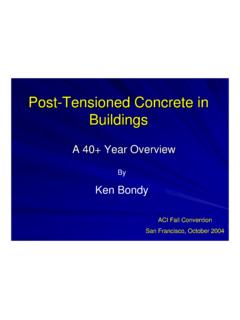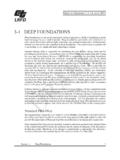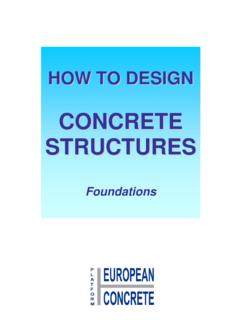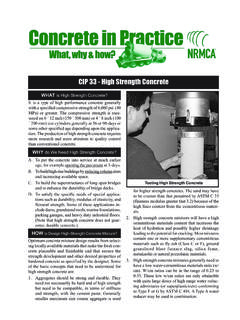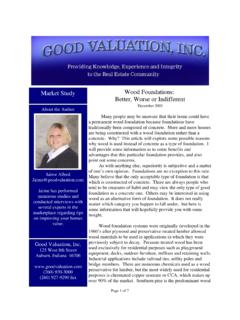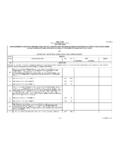Transcription of CODE REQUIREMENTS FOR SULFATE DURABILITY …
1 February 2008 | PTIJOURNAL|25 code REQUIREMENTS FOR SULFATE DURABILITY IN residential CONCRETEKEN BONDYABSTRACTThe paper describes the current code REQUIREMENTS for sul-fate DURABILITY in residential concrete construction. Thepaper highlights the development of clarifications regard-ing SULFATE DURABILITY REQUIREMENTS in ACI 318-08 andother relevant codes. The myths, facts and legal issues insulfate lawsuits are discussed and the intent of the currentACI and PTI REQUIREMENTS on SULFATE DURABILITY are ; deterioration; SULFATE ; concrete ; crackingPTI Journal, V. 6, No. 1, February 2008 Received and reviewed underInstitute Journal publication policies. Copyright 2008, Post-TensioningInstitute.
2 All rights reserved, including the making of copies unless per-mission is obtained from the Post-Tensioning Institute. Pertinent discus-sion will be published in the next issue of the PTI Journal if received with-in 3 months from the code changes have been developed recentlywhich apply to the design of residential slabs and founda-tions for SULFATE DURABILITY . These changes affect both post-tensioned and non-prestressed residential buildings. Theyappear in the International Building code (IBC)1, startingwith the 2006 edition, and Building code REQUIREMENTS forStructural concrete , published by the American ConcreteInstitute (ACI 318), starting with the 2008 edition (whichis scheduled for publication in January of 2008)2.
3 Thechanges were made to clarify code SULFATE durabilityrequirements, to make the codes consistent with long-standing successful practices, to recognize the differencesin DURABILITY demands between plain concrete residentialfoundations and reinforced concrete members in commer-cial buildings, and to avoid misinterpretation, intentionalor unintentional, by users of the codes. One reason for making these code changes involved themany lawsuits that have been filed in southwestern states inwhich SULFATE DURABILITY of concrete in residential buildingswas an issue. In these lawsuits building code interpretationwas a major consideration. It is important for design pro-fessionals and contractors involved in residential construc-tion to be aware of the current code criteria for sulfatedurability.
4 This paper discusses the current and pendingrelevant building code REQUIREMENTS governing sulfatedurability for both post-tensioned and non-prestressedresidential foundation concrete work, and also presents abrief history of the SULFATE LITIGATION HISTORYS ince the early 1990s many hundreds of lawsuits have beenfiled in California, Nevada, and Arizona alleging that theconcrete foundations supporting thousands of single andmulti-family wood-framed residences violated code sulfatedurability REQUIREMENTS . Some of the homes involved inthese lawsuits had post-tensioned slabs and foundations;others had non-prestressed foundations. The specific crite-ria alleged to be violated are those found in Table ofthe ACI codes from the 1983 edition (ACI 318-83) throughthe 2005 edition (ACI 318-05), and the Uniform BuildingTECHNICAL PAPERFeb 2008 Journal Technical Paper 3 Bondy:Layout 1 3/7/2008 12:54 PM Page 2526| PTIJOURNAL | February 2008 Codes into which those ACI codes were incorporated(UBC-85, 88, 91, 94 and 97).
5 Hereinafter ACI 318-05 , and the corresponding tables with various table iden-tification numbers incorporated into the Uniform BuildingCodes, will collectively be called the SULFATE table. The sul-fate table appeared in ACI 318-05 as shown in Table wording of the older codes was not clear as to theapplicability of the SULFATE table to residential concretework. The codes could be wordsmithed both ways, eitherthat the SULFATE table did apply or that it did not apply toresidential buildings. Plaintiffs in these lawsuits arguedthat the SULFATE table did apply; defendants argued that itdid not apply. The plaintiff argument was simple: the sul-fate table is right there in the code .
6 The plaintiffs, in trialsand presentations, often displayed large pictures of the sul-fate table, which was obviously felt to support their posi-tion. The defense acknowledged that the table was in thecode, but they argued that it was in a part of the code whichapplied only to reinforced concrete , one of the two ACIcode categories for structural concrete . residential founda-tions, the defense argued, were almost always designedunder the code category of structural plain concrete , andthey cited code wording that suggested that the sulfatetable did not apply to structural plain concrete . Billions ofdollars changed hands in these lawsuits. Some settlementsexceeded the market value of the homes.
7 In one early casethe plaintiffs were paid $640,000 per home for homes witha market value of about $400,000. To the best of theauthor s knowledge, the repairs proposed as necessary bythe plaintiff to remedy the alleged SULFATE attack have neverbeen executed in any of the roughly 5,000 plaintiff homesinvolved in these lawsuits. That fact sheds some light onthe seriousness of SULFATE attack in residential foundationconcrete work, and the merits of the claims in the HAPPENS IN PRACTICE?There has been no lack of clarity in the historical practiceof residential concrete design and construction; clearly inpractice the SULFATE table, particularly its REQUIREMENTS forwater-to-cementitious materials ratio (w/cm), did notapply.
8 Prior to the filing of the first of these lawsuits, designprofessionals rarely required full conformance to the sul-fate table for residential concrete work, and building offi-cials virtually never enforced the table. This establishedstandard of practice was the reason why the plaintiff attor-neys were able to find hundreds of residential projects onwhich they correctly alleged that the concrete work failedto satisfy the REQUIREMENTS of the SULFATE table. At issue inthese cases was whether residential concrete work wasrequired to satisfy the SULFATE table, either by code or bystandard SULFATE table first appeared in an ACI code in 1983 (itwas mentioned in the Commentary to ACI 318-77), and itsfirst appearance in a Uniform Building code was in SULFATE table establishes four categories of soil sulfateexposure, negligible, moderate, severe, and very severe, eachdefined by the percentage of water-soluble sulfates con-tained by weight in the soil.
9 For the severe and very severecategories, the SULFATE table requires the use of a SULFATE -resistant cement (Type V or equivalent) and an upper limiton water-to-cementitious materials ratio (w/cm) of For decades prior to the first appearance of the SULFATE tablein building codes, geotechnical and structural engineersdesigning residential buildings in areas of high soil sulfatesnormally specified the use of SULFATE -resistant cements, butdid not require any limitations on w/cmbeyond thatinherent in the specified concrete compressive strength f concretes used in residential slab and foundationwork were specified to have compressive strength betweenTABLE REQUIREMENTS FOR concrete EXPOSED TO SULFATE -CONTAINING SOLUTIONSS ulfateexposureWater soluble sul-fate (SO4) in soil,percent by weightSulfate (SO4)
10 In water,ppmCement typeMaximum water-cementi-tious material ratio, byweight, normalweightconcrete*Minimumfc , normal-weight and lightweightconcrete, psi* SO4< SO4< 150 Moderate SO4< SO4< 1500II, IP(MS), IS(MS), P(MS),I(PM)(MS), I(SM)(MS) SO4 SO4 10, severeSO4> > 10,000V plus pozzolan * When both Table and Table ar e considered, the lowest applicable maximum water-cementitious material ratio and highest applicable minimumfc shallbe used. Seawater. Pozzolan that has been determined by test or service record to improve SULFATE resistance when used in concrete containing Type V 1 - SULFATE Table (Table from ACI 318-05)Feb 2008 Journal Technical Paper 3 Bondy:Layout 1 3/7/2008 12:54 PM Page 262,000 and 3,000 psi, and those strengths were roughly con-sistent with w/cmratios between and respectively.

